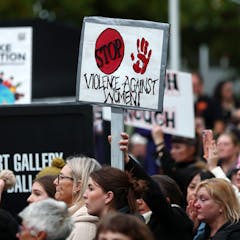
Articles on Domestic violence
Displaying 1 - 20 of 496 articles

Women who have moved to Australia, particularly from traumatic settings, are particularly at risk of gendered violence. Here’s what our research found helps them to speak up.

Australian laws fall well short of protecting women from an abusive partner’s debts by adopting a US law removing their liability.

Some countries closer to achieving gender equality still have high rates of domestic violence, but look a bit closer and you’ll see the full story.

New research shows police specialising in family violence are concerned current approaches leave victim-survivors unprotected.

Confiscating firearms from alleged abusers might seem like a good idea, but it’s unlikely to make much of a difference.

After historic win, President-elect Claudia Sheinbaum will face pressure to address her country’s gender violence.

Evidence suggests that some individuals who hurt animals likewise act violently toward women and girls. Exploring that overlap can help prevent gender-based violence and animal abuse.

While federal politics often seems top down on most issues fighting social media’s grip on children, the pressure now comes from the bottom up.

First Nations women are 32 times more likely to be hospitalised as a result of domestic violence than non-Indigenous women. We need to put Indigenous women at the centre of the discussion.

The budget will respond to the deepening public agitation over Australia’s housing shortages by pouring new money into crisis accommodation for women and children, social housing and infrastructure.

This is not the first time domestic violence has been declared a national crisis. Australian governments first got seriously involved in 1985. What can the past 40 years teach us?

Nearly all countries in the region have criminalised either femicide or feminicide, which has had a tremendous impact on society.

We need to look at the roots of gendered violence, including the experiences and behaviours of perpetrators.

Government bodies and community organisations have tried to tackle the problem of violence against women in marketing campaigns. Have they worked?

A domestic violence disclosure scheme is a resource people can check to find out if a particular person has a documented history of domestic violence.

In this podcast, we're joined by Dr Anne Summers, a longtime writer and advocate on women's issues to discuss the horrific number of women murdered this year.

Public focus on, and anger about, the horrifyingly high rates of violence against women is at fever pitch. What have the country’s leaders agreed to, and will it fix the problem?

The government will introduce legislation to ban deepfake pornography and devote $925.2 million over five years to establish permanently a program with those eligible able to receive up to $5000.

Domestic violence is not just a critical social and health issue, but a major economic challenge for victim survivors and the nation.

Gender violence has captured the attention of policy makers and the public. There’s many things that can be done, both in the short and long term.





